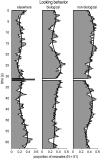Four-day-old human neonates look longer at non-biological motions of a single point-of-light
- PMID: 17264887
- PMCID: PMC1779622
- DOI: 10.1371/journal.pone.0000186
Four-day-old human neonates look longer at non-biological motions of a single point-of-light
Abstract
Background: Biological motions, that is, the movements of humans and other vertebrates, are characterized by dynamic regularities that reflect the structure and the control schemes of the musculo-skeletal system. Early studies on the development of the visual perception of biological motion showed that infants after three months of age distinguished between biological and non-biological locomotion.
Methodology/principal findings: Using single point-light motions that varied with respect to the "two-third-power law" of motion generation and perception, we observed that four-day-old human neonates looked longer at non-biological motions than at biological motions when these were simultaneously presented in a standard preferential looking paradigm.
Conclusion/significance: This result can be interpreted within the "violation of expectation" framework and can indicate that neonates' motion perception - like adults'-is attuned to biological kinematics.
Conflict of interest statement
Figures


Similar articles
-
Two-day-old newborns learn to discriminate accelerated-decelerated biological kinematics from constant velocity motion.Cognition. 2020 Feb;195:104126. doi: 10.1016/j.cognition.2019.104126. Epub 2019 Nov 12. Cognition. 2020. PMID: 31731117
-
Preference for point-light human biological motion in newborns: contribution of translational displacement.Dev Psychol. 2014 Jan;50(1):113-20. doi: 10.1037/a0032956. Epub 2013 May 13. Dev Psychol. 2014. PMID: 23668800
-
Infant perception of sex differences in biological motion displays.J Exp Child Psychol. 2018 Sep;173:338-350. doi: 10.1016/j.jecp.2018.04.006. J Exp Child Psychol. 2018. PMID: 29807312 Free PMC article.
-
Visual development in ontogenesis: some reevaluations.Adv Child Dev Behav. 1980;15:1-52. doi: 10.1016/s0065-2407(08)60124-x. Adv Child Dev Behav. 1980. PMID: 7010953 Review. No abstract available.
-
Sensory memory for ambiguous vision.Trends Cogn Sci. 2008 Sep;12(9):334-41. doi: 10.1016/j.tics.2008.05.006. Epub 2008 Aug 4. Trends Cogn Sci. 2008. PMID: 18684661 Review.
Cited by
-
Disrupted action perception in autism: behavioral evidence, neuroendophenotypes, and diagnostic utility.Dev Cogn Neurosci. 2012 Jan;2(1):25-35. doi: 10.1016/j.dcn.2011.05.005. Epub 2011 May 27. Dev Cogn Neurosci. 2012. PMID: 22682727 Free PMC article. Review.
-
Single point motion kinematics convey emotional signals in children and adults.PLoS One. 2024 Apr 10;19(4):e0301896. doi: 10.1371/journal.pone.0301896. eCollection 2024. PLoS One. 2024. PMID: 38598520 Free PMC article.
-
Frame of reference for visual perception in young infants during change of body position.Exp Brain Res. 2007 Dec;183(4):523-9. doi: 10.1007/s00221-007-1070-5. Epub 2007 Aug 2. Exp Brain Res. 2007. PMID: 17673991
-
A predisposition for biological motion in the newborn baby.Proc Natl Acad Sci U S A. 2008 Jan 15;105(2):809-13. doi: 10.1073/pnas.0707021105. Epub 2008 Jan 3. Proc Natl Acad Sci U S A. 2008. PMID: 18174333 Free PMC article.
-
Three Months-Old' Preferences for Biological Motion Configuration and Its Subsequent Decline.Brain Sci. 2022 Apr 27;12(5):566. doi: 10.3390/brainsci12050566. Brain Sci. 2022. PMID: 35624952 Free PMC article.
References
-
- Johansson G. Visual perception of biological motion and a model for its analysis. Percept Psychophys. 1973;14:201–211.
-
- Johansson G. Spatio-temporal differenciation and integration in visual motion perception. Psychol Res. 1976;38:379–393. - PubMed
-
- Viviani P. Motor competence in the perception of dynamic events: a tutorial. In: Prinz W, Hommel B, editors. Attention and performance XIX: Common mechanisms in perception and action. NY: Oxford University Press; 2002. pp. 21–28.
-
- Spelke ES, Breinlinger K, Macomber J, Jacobson K. Origins of knowledge. Psychol Rev. 1992;99:605–632. - PubMed
-
- Fox R, Mc Daniels C. The perception of biological motion by human infants. Science. 1982;218:486–487. - PubMed
Publication types
MeSH terms
LinkOut - more resources
Full Text Sources

